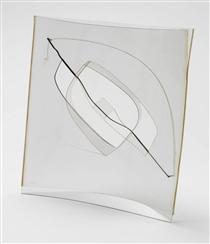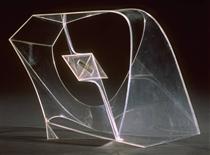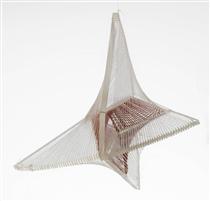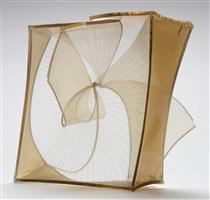
1890 - 1977
Naum Gabo

description
A Russian sculptor of Jewish origin, an artist, stage designer and art theorist who worked in different countries of Europe and for a long time in the USA.
Gabo was one of the pioneers of modern sculpture. Instead of wood, stone or bronze, he used new industrial materials – acrylic glass, plastics and nylon threads. In his abstract spatial constructions, mass and volume – these “cornerstones of traditional sculpture” – turned out to be half-transparent, seemed weightless even with significant weight. A truly unique feature of Gabo’s work is that he was inspired not by nature but the concepts of the exact sciences.
With his ideas on contemporary sculpture, Naum Gabo revolutionized the general understanding of sculpture and its perception, having earned a place in the catalog of “100 artists from ancient Greece to the present, who played a significant role in the development of sculpture, painting and photography” published in the USA.
The leader of the world avant-garde art, N. Gabo belonged to a group of Russian Constructivists (he was an ally of Tatlin, Malevich, Rodchenko) and representatives of the German Bauhaus; moreover, he was a member of the Paris group “Abstraction” of Amsterdam’s “Style”. Gabo decisively influenced modern English sculpture and was awarded the title of “Honorary Knight Commander of the Order of the British Empire”. In addition, the artist became one of the pioneers in the creation of kinetic visual art.
Key ideas:
– In the manifesto of Gabo, co-authored with his brother Pevsner, the essence of their creative credo is expressed succinctly and precisely, “We call ourselves Constructivists because our works are no longer painted or modeled; they are built in space using this space”.
– The formative events for the art of Gabo were the years of study at the medical and engineering faculties of educational institutions in Munich when the aspiring artist got acquainted with the scientific, philosophical and artistic theories of Einstein and Bergson and also read Kandinsky’s treatise “On the spiritual in art”.
– Inspired by Picasso, Gabo was carried away by geometric constructions during his first stay in Paris. Unlike Cubist sculpture, his ideas were more novel: the sculptor refused to carve figures in bulk, as Picasso did, but used sheets of different materials to create them. At the same time, he boldly left a lot of free space. The ideas of the Constructivists of Tatlin’s circle and the Suprematists of the circle of Malevich became important.
– Gabo’s sculptures initiate the connection between tangible and intangible; they are simplified in visual reality and have unlimited possibilities for intuitive imagination. The artist preferred transparent and translucent, rather than “deaf” forms, showed the poetics of voids and openings that interact with the environment.
– He developed creation systems that were used not only for his elegantly designed sculptures but also for architecture. He was also an innovator in the application of a wide variety of materials, including plastics, fishing line, nylon, Perspex sheets.
– Starting to use electric motors to “revive” sculptures, Gabo became one of the pioneers of kinetic art. The idea of movement is closely related to the rhythm of his works; the accuracy of form makes the viewer imagine that he travels around the sculptures.
– Even in the smallest works of the innovator, one can feel the vastness of the space, the grandeur of the concept and time as continuous growth – Naum Gabo was able to realize his idea that art should be active in four dimensions, including time.
1890
1910
1914
1917
1920
1924
1935
1946
1952
1954
1957
1968
1977
Naum Gabo was born into a poor Jewish family
Entered the University of Munich

Settled in Paris

The brothers moved to Moscow

"Realistic Manifesto"

The first solo exhibition

Moved to England

He left for permanent residence in the USA

He became a US citizen

He received the prestigious award "Mr. and Mrs. Frank G. Logan Art Institute Prize”

He supervised the assembly and installation of a 26-meter metal sculpture in Rotterdam

The sculptor was offered an order for a rotating Fountain

The death of the artist

Naum Gabo
On Artist
flow
Constructivism
Kinetic art
Abstractionism
friends
Vladimir Tatlin
Alexander Rodchenko
Kazimir Malevich
Laszlo Mohoy Nagy
artists
Vasily Kandinsky
Pablo Picasso
Alexander Arkhipenko
By Artist
flow
Constructivism
friends
Antoine Pevzner
artists
Pete Mondrian
Barbara Hepworth
Ben Nicholson
John Wells
Peter Lannion
